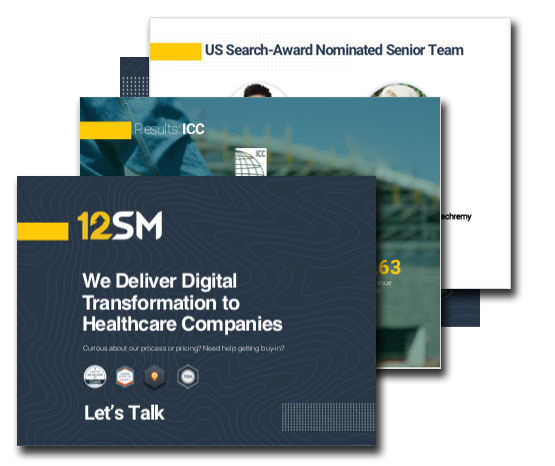Effective SaaS marketing strategies need to be handled differently from the way marketing strategies are used by most companies.
Even when you use the same type of strategy as companies from other industries, your approach needs to be optimized for the way software-based services differ from other types of products and services.
In this article, we cover all things related to SaaS marketing: what it is, how it differs from other marketing strategies as well as specific strategies you can use.
Let’s get into it.
What is SaaS Marketing?
SaaS marketing is a type of marketing in which your primary goal is to sell subscriptions for software-based products.
Software as a service is the name given to software products in which the software itself is sold as a subscription service. Popular SaaS companies you may use every day include Netflix, Spotify, Microsoft 365, Adobe Premiere Pro, etc.
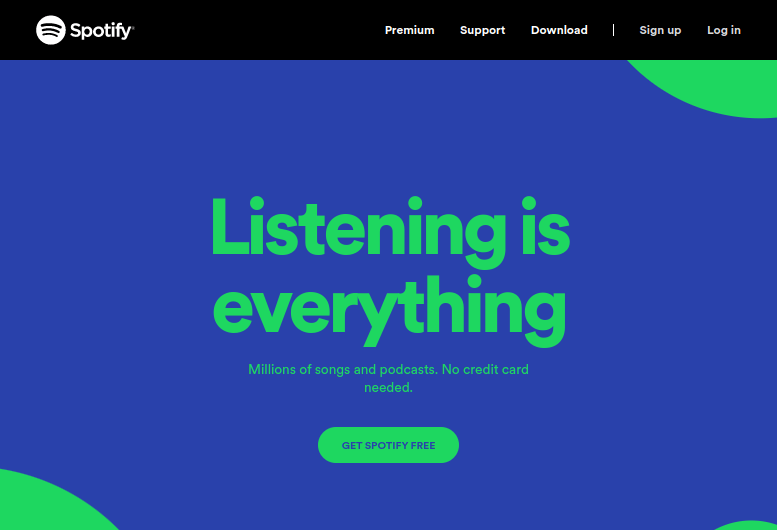
Source: Spotify
The thing about SaaS companies and products is that they come in a variety of different shapes and sizes. They all target different problems and have different methods and philosophies when it comes to how they solve problems and whom they target.
Take a look at our examples. Each one of them is a SaaS company, but Netflix and Spotify are entertainment-based Saas products whereas Microsoft 365 and Adobe Premiere Pro are used more for productivity and work environments.
You can also see how they differ in whom they target. As entertainment-based products, Netflix and Spotify do just fine targeting general consumers with individual subscriptions or small family plans.
However, like office or work-based products, Microsoft and Adobe are much better off targeting larger organizations, such as schools and businesses with numerous employees/devices in need of these types of applications.
As such, all of these companies have very different marketing needs.
Different Types of SaaS Marketing
There are three primary forms of marketing SaaS marketers can utilize inbound marketing, outbound marketing, and account-based marketing.
They each have their own advantages and disadvantages. The ones SaaS companies ultimately choose are dependent on the types of SaaS products they sell as well as their overall marketing goals (more subscriptions, more revenue, etc.).
Let’s go over each type.
Inbound Marketing
Inbound marketing is one of the most popular marketing strategies for SaaS companies as well as one of the most effective, especially as outbound marketing loses its influence.
Both inbound and outbound marketing relies on content to get marketing messages out. The way in which that content acquires customers is where these strategies differ.
With inbound marketing, you use content to pull potential customers in just as you do with outbound marketing, but it’s the type of content you use that makes this strategy so much more effective.
That content typically comes in the form of blog and social media posts, but webinars, emails you send to your subscribers, podcasts, and video content work as well, maybe even better.
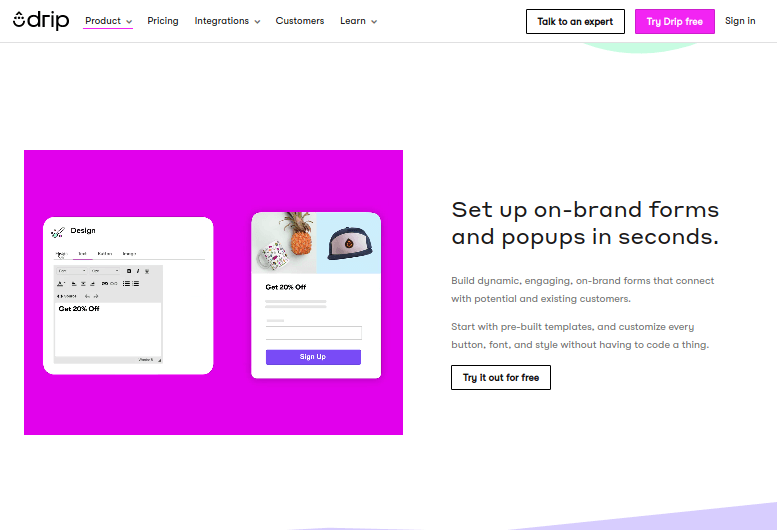
Source: Drip
Both marketing strategies attract customers. The reason inbound marketing is so powerful has to do with the types of potential customers this marketing strategy attracts leads.
Leads are potential customers who have a higher likelihood of subscribing to your product or service.
You can target them with content directly related to the problem(s) your software solves, then capture and nurture them into customers.
Advantages of Inbound Marketing:
- Attract high-quality leads
- Get more mileage out of marketing strategies with evergreen content
- Cheaper in the long run
- Inbound marketing content is less intrusive
- Analytics help you optimize each individual step within an inbound marketing strategy saas
Disadvantages of Inbound Marketing:
- Blog posts and similar content eat up a lot of time
- Inbound marketing channels need constant maintenance
Outbound Marketing
So, if inbound marketing is digital content that attracts leads, what’s outbound marketing?
Inbound marketing can be understood as a form of marketing, such as digital content, that brings customers into your website. This makes it easy to understand how outbound marketing does the opposite.
In outbound marketing, you push (mostly) non-digital forms of content out to a broad range of customers.
Examples of this type of content include TV commercials, billboards, ads in magazines and newspapers, mail, and even trade shows.
This is due to the untargeted way this form of marketing attracts customers.

With educational content relevant to the problem your SaaS product solves, inbound marketing allows you to build a collection of high-quality leads who seem most likely to convert based on their interest in the topic.
Outbound marketing messages, on the other hand, are sent to a broader range of customers in places where consumers are met with numerous advertisements from other companies every day.
Consumers are much harder to target this way. Sure, you can choose magazines or TV channels you feel your target customer may read or watch, but there are fewer ways to target individual problems with this form of marketing.
Advantages of Outbound Marketing:
- Reach a large number of consumers at once
- Faster sales process
- Traditional forms of advertising are more familiar to consumers
Disadvantages of Outbound Marketing:
- Expensive
- No way to target high-quality leads
- Results are unpredictable and harder to track
- Fewer people read magazines or watch TV with commercials these days
Account-Based SaaS Marketing
Account-based marketing is one of the most effective forms of marketing SaaS companies can use, especially if your product is expensive.
With inbound marketing, you target specific markets in hopes of bringing in a barrage of highly-qualified leads you can nurture into customers.

In account-based marketing or ABM, each individual lead becomes its own market, or “account,” allowing you to convert high-value leads into customers by personalizing the buying experience for them.
So, instead of creating a segment that allows you to target large organizations or businesses, you find an actual large organization or business and work with them individually.
By discussing all of the problems they’re experiencing in one-on-one conversations, you can tailor the customer journey and buying experience, including the prices and services you offer, to fit their needs.
They’ll be much more likely to convert in the end than had you targeted them as part of a broad segment in your audience with inbound marketing.
Speaking of inbound marketing, you can combine these two strategies to create a powerful marketing formula that churns out high-value customers who are more likely to pay your higher subscription fees.
Use inbound marketing to attract a segment of highly-qualified leads. Then, use ABM to extract individual, high-value accounts you can target in one-on-one conversations.
Advantages of Account-Based Marketing:
- Convert high-paying customers
- Receive a higher return-on-investment (ROI)
- Earn more revenue with fewer customers
- Provides a way to segment qualified segments even further
Disadvantages of Account-Based Marketing:
- Requires more time and planning
- Fewer customers means big losses if even one leaves
- One-on-one focus must remain even after customer converts
How are SaaS Marketing Strategies Different?
Inbound marketing, outbound marketing, and account-based marketing are not unique forms of marketing nor are they used by the SaaS industry exclusively.
So, what makes SaaS marketing different from other forms of marketing?
It has to do with the SaaS model in general. In SaaS, your product is more of a service than it is a product.
You’re not trying to sell a service or product on a one-off basis. You’re trying to market your product as valuable enough to pay as a subscription-based service on an ongoing basis.
Plus, the problem your software solves or the way it solves that problem probably looks pretty unique when compared to the average product or service.
As such, the way you market your service will look different than a company that provides its services in one-off jobs to individual customers.
Here are a few ways in which SaaS marketing is different:
- You give away your service for free.
- SaaS companies are more likely to sell to other businesses.
- You may sell a SaaS product, but your software is not a product in and of itself.
- Word-of-mouth referrals may make up the majority of new customer acquisitions.
- Content is king for SaaS companies.
Let’s elaborate.
How Free Trials Set SaaS Companies Apart
When a new flavor of Oreos comes out, do you expect to be able to walk into the store and try a few cookies before you buy a whole package?
What about car repairs? Does your mechanic offer to fix a part of the problem for free before you pay for the entire service?
The answer to both of these questions is no, and yet, that’s exactly what SaaS companies do.
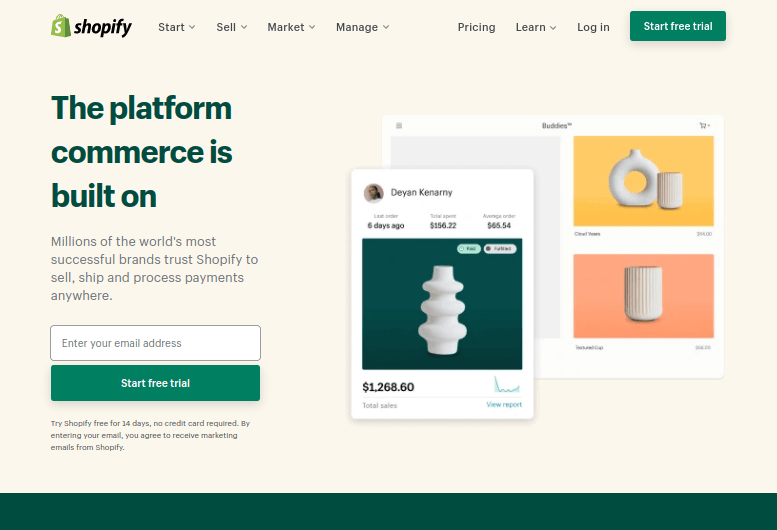
Source: Shopify
Free trials are an integral part of the marketing process for many SaaS companies.
When you allow customers to use your service in full for free on a trial or limited basis, you have a higher likelihood of getting them to convert.
This is because they’re given a real-world example of what your service is capable of and how exactly it solves whatever problem they’re having.
B2B vs. B2C Sales Models
Definitions of these acronyms:
- Business-to-business (B2B) – Selling directly to other businesses.
- Business-to-consumer (B2C) – Selling to general consumers.
If we take a look at our examples from earlier, Netflix, Spotify, Microsoft 365, and Adobe Premiere Pro, we can see that SaaS companies use both of these sales models.
Netflix and Spotify use the B2C sales model. Microsoft and Adobe use both but are much more likely to earn a higher ROI when they utilize the B2B sales model.
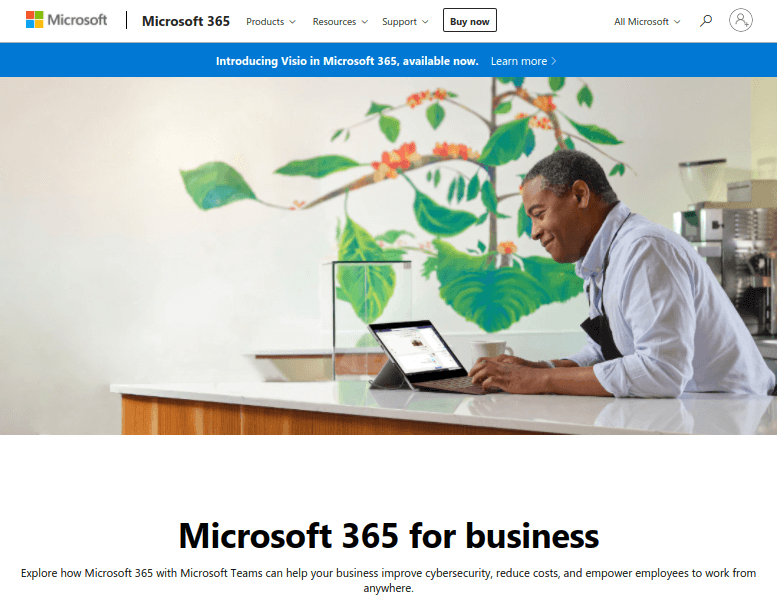
Source: Microsoft 365
As such, many SaaS companies are more likely to tailor their software to fit the needs of larger businesses. The higher revenue helps to offset costs for hosting, customer service, ongoing maintenance of the software, and further development.
The process for sales SaaS marketing is also shorter when compared to other forms of marketing.
Even when companies use the B2B sales model, the sales process is much shorter than the typical months-long sales process other types of companies utilize when selling to other businesses.
The reason likely ties back into the free trial model in which customers are able to test the software in full on their own before they buy.
Software as a Service vs. Software as a Product
When you develop an application and ship it off to customers, you may be inclined to see it as a product you charge a subscription for rather than a service.
However, SaaS marketing is different in this regard as it’s most successful when you treat your software as a service rather than a product.
This is because products typically solve temporary problems one-off whereas your software should provide a service for a continuous or recurring problem your customer has, making a monthly or annual subscription necessary.
The distinction between product and service will change the way you approach what your software does, how you market it and what each subscription tier offers.
Plus, the B2B sales model often requires you to interact closely with business customers. This extra layer of one-on-one service is not often seen when software is sold as a product.
Product-Market Fit
Product-market fit has to do with your status in a particular market and how much influence you have over it in comparison to your competitors.
In a product-market fit scenario, recurring subscriptions and word-of-mouth referrals contribute to a greater portion of your revenue than other strategies do.
You may even be the go-to SaaS company in your market.
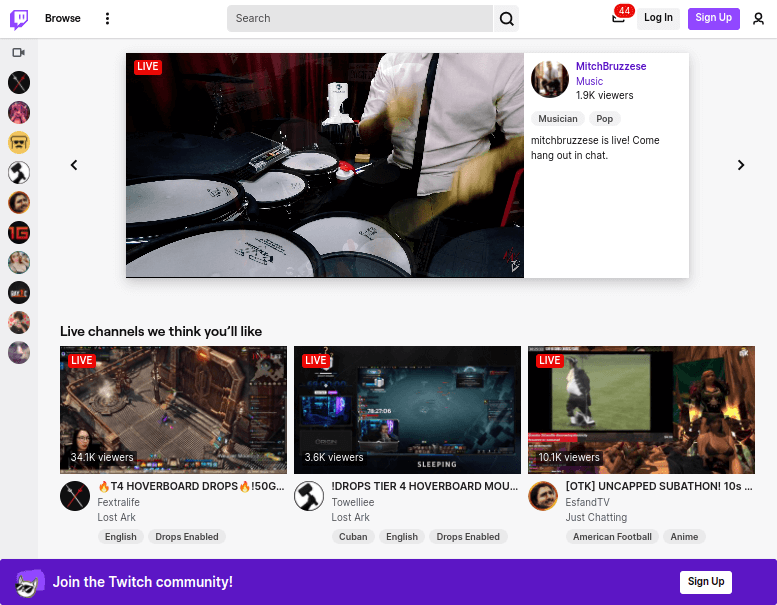
Source: Twitch
Take Twitch as an example. It’s a live streaming platform primarily tailored toward gamers, though other content exists on the platform as well.
Even so, an overwhelming majority of gaming live streams are broadcast through Twitch so much so that competitors, including YouTube Gaming, struggle to keep up or even stay afloat.
This is the success you should strive to achieve with your own SaaS company. It’s even something investors look out for.
SaaS marketing metrics we can use to calculate product-market fit include revenue and retention rate. However, you can’t just look at these numbers plainly and get an idea of where you stand in the market.
You have to compare them with your competitors, which may be difficult if they don’t share this information publicly.
Fortunately, there are a few additional signals you can look out for to determine if you’re headed in the right direction.
They include whether or not potential customers indicate they will switch to your service from a competitor’s as well as if potential customers are willing to give your service a try despite not being satisfied with similar services.
If you’re in a product-market fit scenario, you can tailor your SaaS marketing strategy to include this influence when you target new customers.
You may even be able to take a step back from marketing as customers do the work for you.
The Importance of SaaS Content Marketing Strategy
We’ll talk about this more in the next part of the article, but we wanted to include it here to explain the role content has in separating SaaS marketing from other forms of marketing.
Sure, a lot of companies include content marketing strategies in their overall tested SaaS marketing strategies, but no one does it quite like SaaS companies.
As a SaaS company, you’ve developed software designed to solve a particular problem for your customer.
You probably know or have learned a lot of information about that problem throughout the development and sales process.
This information is an asset, one you should include in your marketing strategy.
An example of a SaaS company that’s killing the content marketing game is HubSpot.
This is a digital marketing SaaS company, but most are familiar with their content.
You’ll often see articles from them on the first page of results for search terms related to their niche.
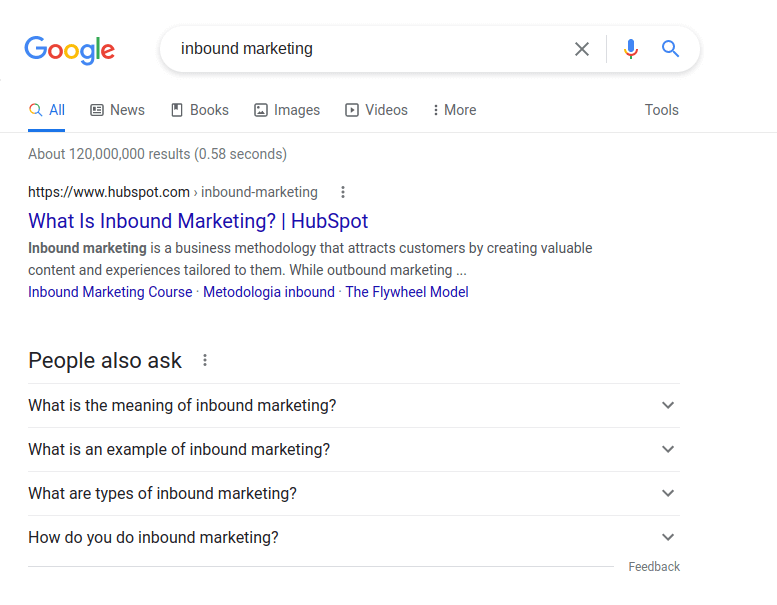
Source: Google
It’s a great inbound marketing strategy: create articles that teach solutions to potential customers all while leading them through sales funnels that promote your software as the ultimate solution.
But again, we’ll get to this strategy in a bit in our next section: a handful of SaaS marketing strategies for you to use.
SaaS Marketing Plan in 2022
Establish EAT (Expertise, Authority, Trust) in Your Industry.
EAT. This simple acronym contains three structures for you to build your marketing strategy around: expertise, authority and trust.
Achieving these pillars will help you achieve the goals you have for your SaaS company as a whole.
Establish your marketing goals before you implement this new marketing strategy or any marketing strategy. Come up with a specific target to hit for revenue or the number of recurring subscriptions you have.
Monitor these SaaS marketing metrics closely so you can keep track of your progress.
You should also keep an eye on your competitors so you can monitor your progress as far as product-market fit goes.
The pillars of EAT are all dependent on one another.
Establishing expertise in your industry will help you become an authoritative voice in your niche, but you can’t establish either of these without the trust of your audience.
Content marketing, especially in the forms of blog posts, podcasts and videos, is the most effective way to do that.
By creating a large collection of content for relevant topics in your industry, you can become the go-to source for knowledge in your niche.
This will lead to higher metrics for traffic and keyword rankings, which will only help to increase your authority.
As potential customers see your website pop up more and more in search results and as outgoing links on other blogs, they’ll begin to trust your brand and what you have to say more and more.
Free trials help to establish trust as well. What better way to let customers see the quality of your software and how much it could help them than to have them test it out for themselves, no strings attached?
Keep EAT and its pillars in mind as we run through the rest of these strategies.
Content Marketing for SaaS Companies
According to EAT, your goal with content marketing should be to establish your expertise in your niche as a way to increase your authority and your audience’s trust in you.
There are a few different ways you can approach content as a SaaS company:
- Publish content on topics related to your niche.
- Create content that teaches customers how to use your software effectively.
- Combine the two by creating content that shows potential customers how to solve problems in your niche with your software.
Take some time to learn about the biggest pain points your target audience is experiencing. Then, come up with a list of content ideas.
You should then determine what types of content you want to create: blog posts, podcasts, or videos on platforms like YouTube and TikTok.
Blog posts require less work in the long run because you can fill them with evergreen content that ranks high in search engines for years to come.
Podcasts and video content are fantastic for reaching a much larger audience, but your relevance on platforms that support these types of content only remains for as long as you publish content.
In short, podcast episodes and videos don’t have long shelf lives on their respective platforms. They get the majority of their views within the first week of publishing with views tapering off from there.
If you have the time or budget to produce new podcasts or video content regularly, you may have a great marketing opportunity on your hands.
Otherwise, many SaaS companies do well with blogging alone. Plus, blogging brings customers directly to your website.
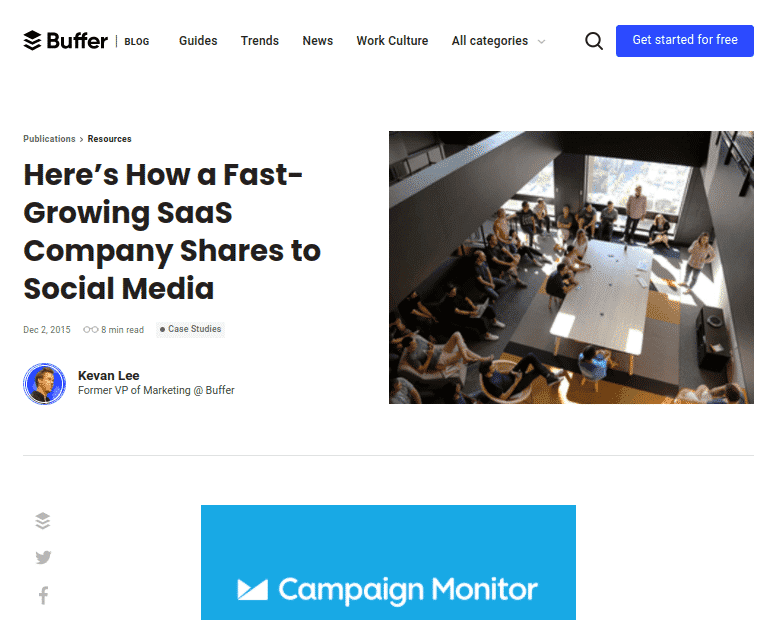
Source: Buffer
On top of blog posts, here are a few types of content that work really well for SaaS:
- Pillar Content – Longform posts (5,000+ words) that tackle key concepts within your niche. Create between two to five pieces of pillar content for your blog with each one targeting a primary keyword you want your website to rank for no matter how competitive it is.
- Case Studies – Data-driven blog posts that tell a story. Here’s an example from social media marketing SaaS company Buffer whose software helped email marketing SaaS company Campaign Monitor manage their social media marketing strategy. Use account-based marketing to work one-on-one with clients, and turn their success stories with your software into case studies that draw in more customers.
- Whitepapers – In-depth, authoritative articles that educate customers or present solutions to problems in direct relation to features of your software or parts of your service. These are not blog posts and should instead be offered as email freebies to capture leads.
Establish Authority by Generating Buzz and Awareness
HubSpot has a huge presence in the marketing industry. According to Similarweb, their website receives over 30 million visits per month.
This is the power blogging and content marketing as a whole provides to SaaS companies.
As you start producing targeted, authoritative content, keep an eye on metrics related to the amount of traffic you’re receiving, your SEO rankings mentions across the web, and the number of backlinks you receive.
You’ll receive backlinks naturally as you gain more authority. However, there are a few whitehat link building strategies you can use as well.
The first is the good ‘ol guest post strategy. Many marketers feel guest posting isn’t worth the effort these days, but you just need to change your mindset about it as well as how you approach it as a link building strategy.
What guest posts do is help you generate awareness for your brand. Publishing posts to numerous influential blogs in your niche is the blogging form of appearing on talk shows, other people’s YouTube channels, and podcasts.
As for how to approach guest posting as a link building strategy, don’t ask to include a link to your website in your author bio.
Instead, create an authoritative piece of content for the blog you’re creating content for, and include a link to your content naturally somewhere in the post itself.
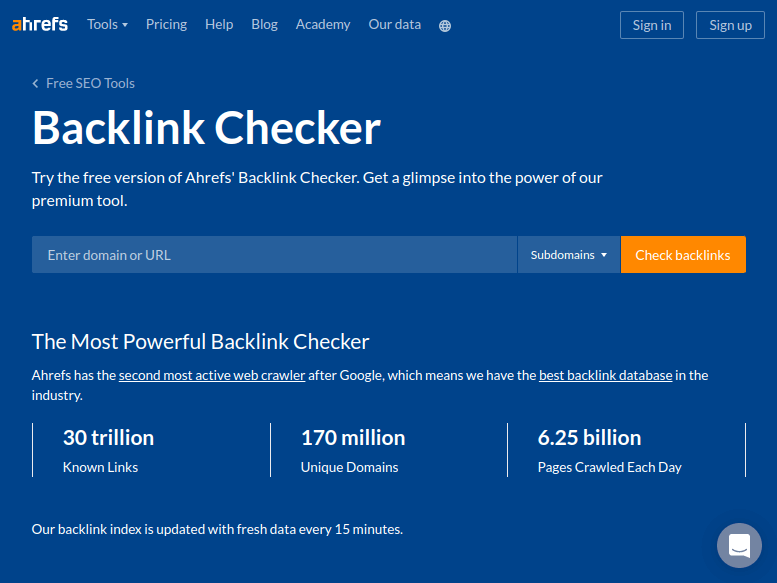
Source: Ahrefs
The second link building strategy involves the pillar content you create. With pillar content, your article should outshine all other articles on the topic.
You can then use tools like Semrush, Ahrefs, Linkminer, and Ubersuggest to find each competitor’s backlinks.
Email the websites each backlink originates from, and request for them to link to your website instead.
This strategy works best when you target outdated or thin competing pages.
Partnering with Others to Market Your SaaS Services
The SaaS industry as a whole is massive. Even your targeted niche within this industry may be pretty huge.
An industry this large has many opportunities for partnerships that can help both parties grow in terms of authority and revenue.
These include affiliates, co-marketers, channel sale partners, and strategic partners.
You’re probably familiar with the way affiliate marketing works.
You provide exclusive links for influencers in your niche to use to promote your service. When someone clicks one of these links and subscribes to your service, you give a percentage or flat fee of their payment to your affiliate as a commission.
You can offer commissions for first-time subscriptions only or for every month subscriptions remain active.
Affiliate marketing offers a great way to turn your most influential customers into advocates.
Co-Marketing
Co-marketing is a partnership you form with a non-competing company to develop a marketing campaign or feature addition that promotes both of your products/services.
An example of a popular co-marketing partnership was when Doritos teamed up with Taco Bell to create the Doritos Locos Tacos menu item.
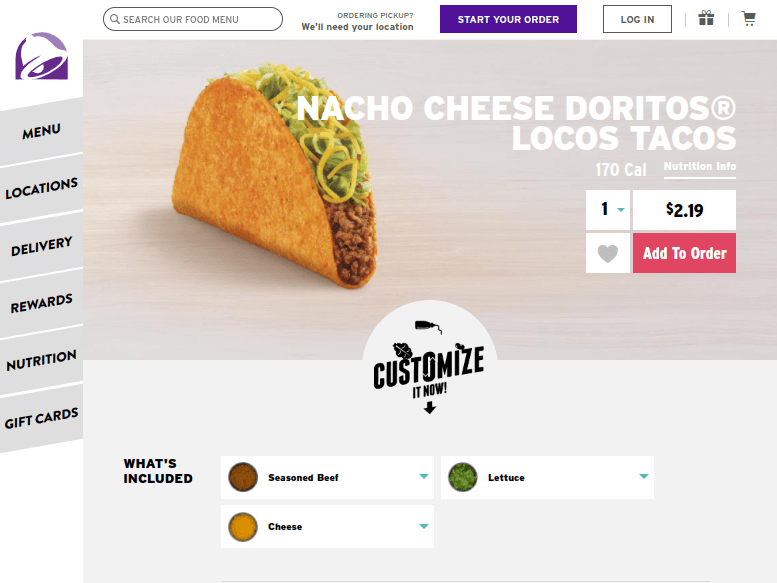
Source: Taco Bell
The partnership provides a high-value customer in Taco Bell to Doritos while Taco Bell gets to utilize one of the most popular snack brands in its marketing campaigns.
You can use this marketing strategy as well by forming your own partnerships.
Choose partners you feel best match your target audience without needing to partner up with competitors. You can also choose partners based on feature additions you feel would benefit customers most.
Partnering with charity organizations works as well.
Other Channel Sales Partners
Affiliate marketing and co-marketing are two examples of channel sales partnerships you can form in your niche, but there are a few additional types of channel sales partners or communities you can form alliances with as well.
These partnerships have advantages and disadvantages no matter which kind you go for.
For example, if you wind up on the “Doritos” side of a partnership, you won’t have any contact with end-users and are, therefore, cut off from the SaaS sales process.
Other examples of this type of partnership include:
- Value-Added Resellers – VARs purchase third-party software and bundle them together.
- Distributors – Save time and money by partnering with distributors, who provide direct lines to customers.
- System Integrators – System integrators bundle your software with others on new computers and similar devices.
- Managed Service Providers – MSPs work as outsourced IT departments for companies who don’t have their own IT departments. They often provide long lists of services related to IT for this reason and utilize third-party software to do so, which could include your software.
Final Thoughts
As you put more effort into your SaaS marketing strategy, there are a number of key performance indicators (KPIs) you can keep track of to monitor your progress:
- Traffic – The amount of traffic your content marketing, social media marketing and link building strategies bring to your website.
- Signups/Conversions – The number of new subscriptions your marketing strategy as a whole brings to your company as well as your conversion rate per campaign.
- Cost-Per-Lead (CPL) – CPL is the amount of money it takes to generate an individual lead. It usually applies to advertising where CPL is calculated via a simple formula: dividing the cost of an ad by the number of leads it generated. To calculate CPL from other types of campaigns, determine the amount of money you spent on a campaign, then divide that number by the number of leads it generated. This is your CPL.
- Churn Rate – The number of customers who leave your service. There are two churn rate metrics you should be concerned about: customers who signed up for free trials but did not subscribe and subscribers who canceled their subscriptions.
- Customer Lifetime Value (CLV) – The amount of money an individual customer generates for your business throughout your entire relationship together. Use the average time customers stay subscribed to your service to determine this metric. It should cost less to keep existing subscribers than it does to generate new ones, so this is an important metric to keep track of.
If you’re still overwhelmed by all of this, be sure to get in touch with our agency.
We specialize in SaaS marketing, offering services for content, SEO, PPC, and social media.




